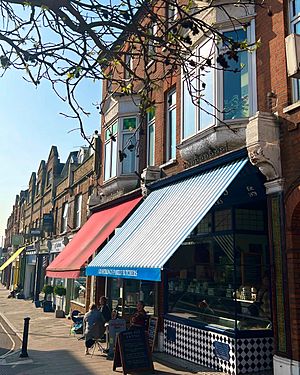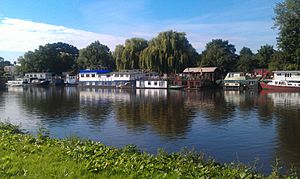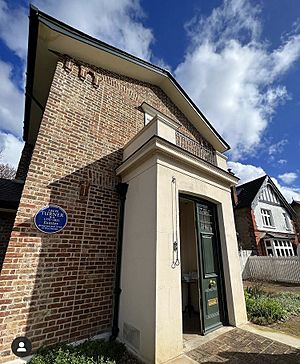St Margarets, London facts for kids
Quick facts for kids St Margarets |
|
|---|---|
 Independent shops and cafes in Crown Road, St Margarets |
|
| Population | 3,872 2011 census: loosely associated electoral ward |
| OS grid reference | TQ168742 |
| London borough | |
| Ceremonial county | Greater London |
| Region | |
| Country | England |
| Sovereign state | United Kingdom |
| Post town | TWICKENHAM |
| Postcode district | TW1 |
| Dialling code | 020 |
| Police | Metropolitan |
| Fire | London |
| Ambulance | London |
| EU Parliament | London |
| UK Parliament |
|
| London Assembly |
|

St Margarets is a lovely neighborhood in London, about 9 kilometers (or 5.6 miles) west of the city center. It's located by the River Thames to the northeast and the River Crane to the northwest. Some parts closer to Richmond Bridge are called East Twickenham. People often refer to both areas as Twickenham. In the 1800s, the southern part of St Margarets was even known as Twickenham Park.
This area is home to a house built by the famous painter J. M. W. Turner. The St Margarets train station is also very close to Marble Hill House.
St Margarets is special because it's one of the few places in London named after a house, not a church. It got its name from a large house and its land that belonged to an important person in the 1700s. A church named after Saint Margaret was built much later, in 1930.
Contents
History of St Margarets
In 1261, a group of powerful barons and their men camped in the southeast part of this area. This was during a small civil war, a power struggle between King Henry III of England and the nobles. This conflict eventually led to important changes in how England was governed, giving more power to a parliament and limiting the king's ability to tax people.
The name "St Margarets" comes from the old Saint Margaret's House. The second version of this house stood from 1827 to 1853. It was the country home of Archibald Kennedy, 1st Marquess of Ailsa. Later, it became the home of the Earl of Kilmorey. You can still see their names in local street names like Kilmorey Gardens and Ailsa Road.
Most of the houses in St Margarets today were built during the Victorian and Edwardian eras (late 1800s and early 1900s). In 1854, the St Margaret's Estate was planned to build family homes. It was one of the first "garden suburbs," designed with lots of green spaces.
The area really grew when the railway arrived. The new train station was first going to be called "Ailsa Crossing" because it went through the estate. But before it opened, it was named "St Margarets."
In April 2017, a special memorial was put up to remember 6,000 Belgian refugees. Many of these adults lived and worked in the area during the First World War. The memorial is by the River Thames at Warren Gardens.
Fun Annual Events
Every July, the St Margarets Fair is held in Moormead Park. This park is by the River Crane, on the western edge of the neighborhood. It's a great community event!
Interesting Buildings to See
Turner's House
In 1814, the famous painter J. M. W. Turner built a house called Solus Lodge on Sandycoombe Road. This house, now known as Sandycombe Lodge, is still standing today!
Gordon House
Gordon House is a beautiful old Georgian mansion right on the River Thames in St Margarets. It's a Grade II-listed building, which means it's historically important. Like Saint Margaret's House, it was once owned by Lord Kilmorey. It even has a special part added in 1738 by the famous architect Robert Adam. For many years, it was used by Brunel University. Recently, it has been turned into private homes.
Kilmorey Mausoleum
The Kilmorey Mausoleum is a unique building that has been moved several times. It's now on the northern edge of St Margarets. It was built in the 1850s by the 2nd Earl of Kilmorey. It holds the bodies of the Earl and his partner, Priscilla Anne Hoste. This building looks like an ancient Egyptian monument and is also a Grade II* listed building. It's sometimes open for visitors to see.
Churches in St Margarets
The Roman Catholic Church of St Margaret of Scotland on St Margarets Road has a modern design. It opened in 1969 and became a Grade II listed building in 1999. Before this, a church stood on the site from 1938.
Schools in the Area
There are three main schools nearby in Twickenham:
- Orleans Park School (for older students)
- St. Stephen's Primary School (for younger students)
- Orleans Primary School (for younger students)
Local Shops and Town Life
St Margarets has two main streets with lots of shops, cafes, and restaurants. Twickenham Studios, a famous film studio, is right in the middle of the village and plans to grow even more.
The main street is known for its popular local and independent businesses. Most of the roads are for homes, and many have beautiful trees. The most common type of house is a semi-detached home. Some larger houses have been divided into apartments. To the east of the "village" are the green areas and classical apartment buildings of Twickenham Park.
Neighboring Areas
St Margarets is surrounded by several interesting places:
- East Twickenham and Cambridge Park are to the southeast.
- Richmond is across the river to the east. You can reach it by Twickenham Bridge, Richmond Bridge, and the Richmond Lock Footbridge.
- Twickenham is to the west and south.
- Old Isleworth and the Ivybridge estate in Isleworth are to the north and northwest.
Between Richmond Lock and Kew Bridge, the River Thames has beautiful green, wooded areas on both sides. These include Kew Gardens, a golf course, and Syon Park.
Marble Hill House and Marble Hill Park are also very close by, just to the south.
Getting Around St Margarets
Road Travel
A busy road called Chertsey Road (A316) cuts through St Margarets. This road connects central London to the M3 motorway. Many parts of south St Margarets have special parking rules to make sure residents can find spaces.
Train Travel
From St Margarets station, trains run four times an hour to and from Waterloo. Both Richmond and Twickenham stations are a short bus ride away and offer faster train services.
Bus Travel
Two bus routes go through St Margarets:
- The 110 bus travels between Hounslow and Hammersmith.
- The H37 bus travels between Hounslow and Richmond.
Other bus routes like 33, R68, R70, and 490 also pass nearby.
Famous People from St Margarets
Many interesting people have lived in St Margarets!
People Living Here Now
| Name | What they do | Connection to St Margarets |
|---|---|---|
| Samantha Bond | Actress (known for James Bond films) | Grew up here and lives here with her husband, actor Alexander Hanson. |
| Milton Jones | Comedian | Lives in St Margarets. |
| Sophie Raworth | Newsreader and journalist | Lives in St Margarets. |
Historical Figures
| Name | Years Lived | What they did | Local Connection |
|---|---|---|---|
| Lynn Faulds Wood | 1948–2020 | TV presenter and health campaigner | Lived here with her husband, journalist John Stapleton. |
| Arnold Gerschwiler | 1914–2003 | Figure skating coach | Lived on Ailsa Road for 53 years. |
| Simon Hoggart | 1946–2014 | Broadcaster and journalist | Lived on Sandycoombe Road. |
| Henrietta Howard | 1734–1767 | Important person at the royal court and friend of King George II | King George II built her Marble Hill House (now a museum) in Marble Hill Park. |
| William Cook Mackenzie | 1862–1952 | Scottish Historian | Lived in Richmond and later on St Georges Road in St Margarets. |
| Garry Marsh | 1902–1981 | Stage and film actor | Was born in St Margarets. |
| J. M. W. Turner | 1775–1851 | Famous English painter | Built his country home, Turner's House, on Sandycoombe Road. It is now open to the public. |





